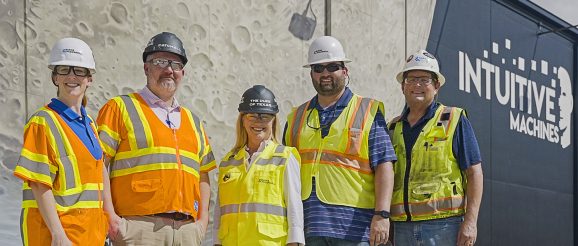US company lands on the moon: Here’s how a KC firm helped boost its flames of innovation

For the first time ever, a commercial spacecraft has touched down on the moon and Kansas City-based Burns & McDonnell provided innovation that helped to make it possible for Intuitive Machines and its Odysseus IM-1 lander, shared Brittany Swartz. The local engineering, construction and architecture firm served as the designer and builder of Intuitive Machines’ new $40 million headquarters and flame range test facility, which opened in September 2023 in the Houston Spaceport. Although Burns & McDonnell was not involved with the moon mission itself, the firm’s team members still feel a sense of pride about how they helped empower the space exploration company, noted Swartz, design manager for the project and Burns & McDonnell aerospace and industrial operations manager. “Getting to work with all those people and knowing that they put their heart and soul into that lander and to see it launch the week before and then land (Thursday), you know their hearts were huge,” she continued. “Your own heart just swells up for that, as well. It was awesome.” “It was a fun project,” added Josh Foerschler, the Burns & McDonnell aerospace, defense, and space business development leader. Burns & McDonnell team members held a watch party — complete with Moon Pies for snacks — Thursday evening at their Kansas City offices as the Intuitive Machines lander reached its destination; the first American spacecraft to reach the surface of the moon since the Apollo program in 1972. “We were here quite late last night, just wanting to see those first images,” Swartz said. “It was great.” Her team started working with Intuitive Machines on the building project in 2021, she said. At the time, the space company had its office and headquarters in a separate location than its manufacturing facility. “Their key engineers had desks in two places, going back and forth,” Swartz explained. “And the opportunity came with Houston Spaceport to be able to build a facility there that actually was even right next door to their manufacturing space.” As the two companies started the ideation process, Swartz noted, they realized they needed to help Intuitive Machines solve another problem: a testing facility for its lunar landing engines that wouldn’t require loading them up onto a mobile vehicular test stand, driving them to an abandoned runway, and setting them up and taking them down in the Houston heat: a process that could take around 12 hours just for one test. So before even starting on the 105,572-square-foot headquarters, the engineering team worked with Intuitive Machines to design the flame range, consisting of a 3,800-square-foot reinforced concrete chamber surrounded by a 25-foot-high perimeter wall that encloses an additional 6,500-square-foot yard and delivers multiple advantages for Intuitive Machines testing protocols, according to Burns & McDonnell. “This highly customized base for our aspirations goes far beyond office space,” said Jack Fischer, vice president of production and operations for Intuitive Machines at the ribbon cutting ceremony for the project in October 2023, according to a Burns & McDonnell news release. “It is an overarching complex with mission control, manufacturing and an advanced propulsion testing facility — the flame range — for the lunar lander engine. This was a facility and test area that didn’t exist before, and now, fueled by innovation, we can bring our vision to life.” They broke ground on the flame range project in October 2021, Swartz shared, and it was up and running within nine months. “That really launched their ability to go faster and deliver their contract with NASA even quicker,” she explained. Burns & McDonnell’s design-build delivery method allowed the engineering team to quickly respond and adapt to the challenges of a project of this scope, Swartz noted. “That allowed us to be able to push the flame range building forward faster,” she continued. “Then we started back on the building and that allowed them to be testing their engine, as well as us figuring out what’s that workflow process for them in their manufacturing space. So the design-build method was really the only solution for them that would have allowed that amount of flexibility to respond to their changes.” “Having this collaborative environment that we had with the design-build mentality with their team meant that we could respond quickly to their changes and react accordingly and not extend the construction even longer,” added Foerschler. “We were solving problems on the fly.”
